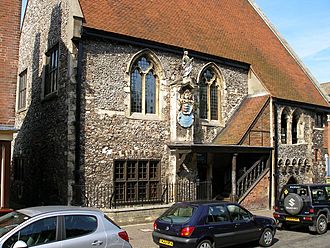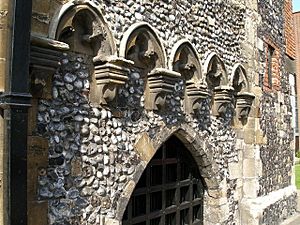The Tolhouse facts for kids
Quick facts for kids The Tolhouse |
|
|---|---|

The Tolhouse, Great Yarmouth in 2007.
|
|
| General information | |
| Town or city | Great Yarmouth |
| Country | England |
| Coordinates | 52°36′14″N 1°43′41″E / 52.604°N 1.728°E |
| Construction started | c. 1150 |
The Tolhouse, also known as the Tolhouse Gaol, is a very old building in Great Yarmouth, England. It was built way back in the 12th century. Over hundreds of years, this building has been used for many different things. It was once a jail, a courthouse, and even a police station. Today, the Tolhouse is a popular museum where you can learn all about its long and interesting past. It is also a special "Grade I listed building," which means it's very important historically.
Contents
The Tolhouse: A Journey Through Time

The Tolhouse was built around the year 1150. People believe that merchants, who were like business owners, built it. It is the oldest public building in Great Yarmouth. It is also one of the oldest buildings still standing in the whole town. The Tolhouse is made from strong materials like flint and ashlar stone. It also has a tiled roof. The main hall inside the building is quite large, measuring about 13.7 meters by 8.2 meters.
From Tolls to Trials: Early Uses
Starting in the 1200s, the Tolhouse was used as a "toll house." This meant that people had to pay a fee, or "toll," there. This toll was usually for herring fish caught near the quay. The building was first called "The Tolhouse" in 1360.
In 1261, King Henry III allowed the Tolhouse to be used as a jail. This jail was in the basement of the building. Many of the people held there were smugglers and pirates. Imagine being a pirate and ending up in this old jail!
Life in the Tolhouse Jail
Life in the Tolhouse jail could be very tough. In the 1400s, some people waited for up to 10 years for their trial. This was a very long time to be held in prison.
In the 1600s, a famous witch-hunter named Matthew Hopkins used the Tolhouse jail. He held trials there for people accused of witchcraft. In the 1700s, prisoners at the Tolhouse had to do hard work. This included walking on a treadmill or picking apart old ropes.
In the early 1800s, a woman named Sarah Martin visited the jail. She was a prison visitor who cared about the prisoners. She thought the cells were too warm and not clean enough. She also felt it was wrong that prisoners could not go to church. Until 1823, prisoners even had to pay fees to stay in jail.
By 1864, inspectors looked at the jail and found problems. They saw that five people were sharing just one room. They suggested that women prisoners should go to a different jail. This would give more space and better conditions for everyone else. The underground cells stopped being used in 1836. Later, these old dungeons became simple storerooms.
The Tolhouse as a Courthouse and Council Room
The main hall of the Tolhouse was also used as a courthouse. Important legal cases were heard there. The building even served as a police station for a while.
In 1552, the local government bought the Tolhouse. They then did a lot of repair work to fix it up. In 1648, the Tolhouse was used as a "council of war" room. This is where important military decisions were made. The very last time the local council met in the building was in 1823.
From Jail to Museum: A New Beginning
In the 1870s, some people wanted to tear down the Tolhouse. But luckily, that did not happen. The Tolhouse jail finally closed in 1878. All the prisoners were moved to Norwich Prison. For a short time after that, the building was used as a town hall.
In 1883, the Tolhouse was given to the mayor of Great Yarmouth. Since then, it has been used as a museum. This means people can visit it and learn about its history. The building was damaged in 1941 during World War II, when bombs fell on Great Yarmouth. It was carefully repaired between 1960 and 1961. In 1953, the Tolhouse was officially named a Grade I listed building. This protects it for future generations.

